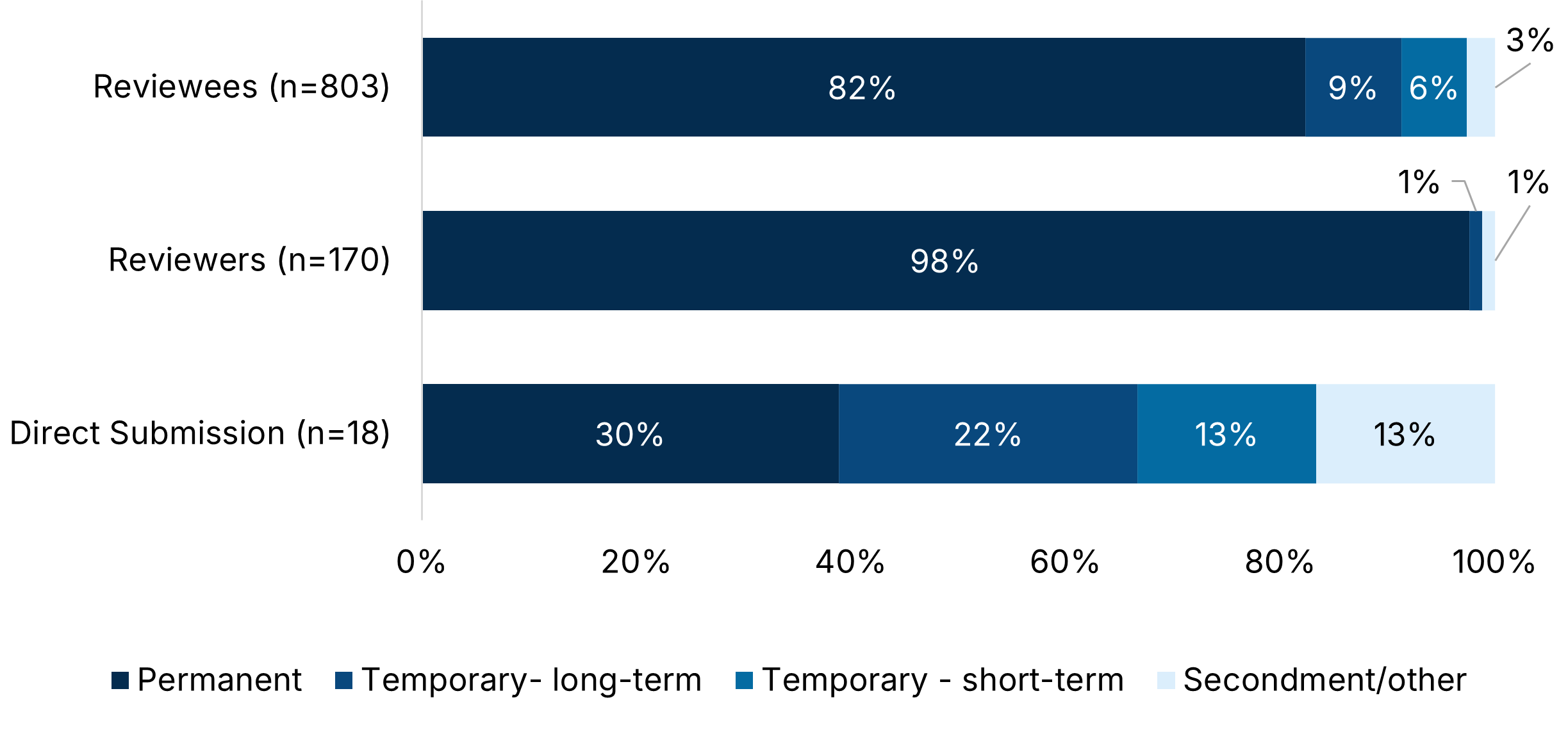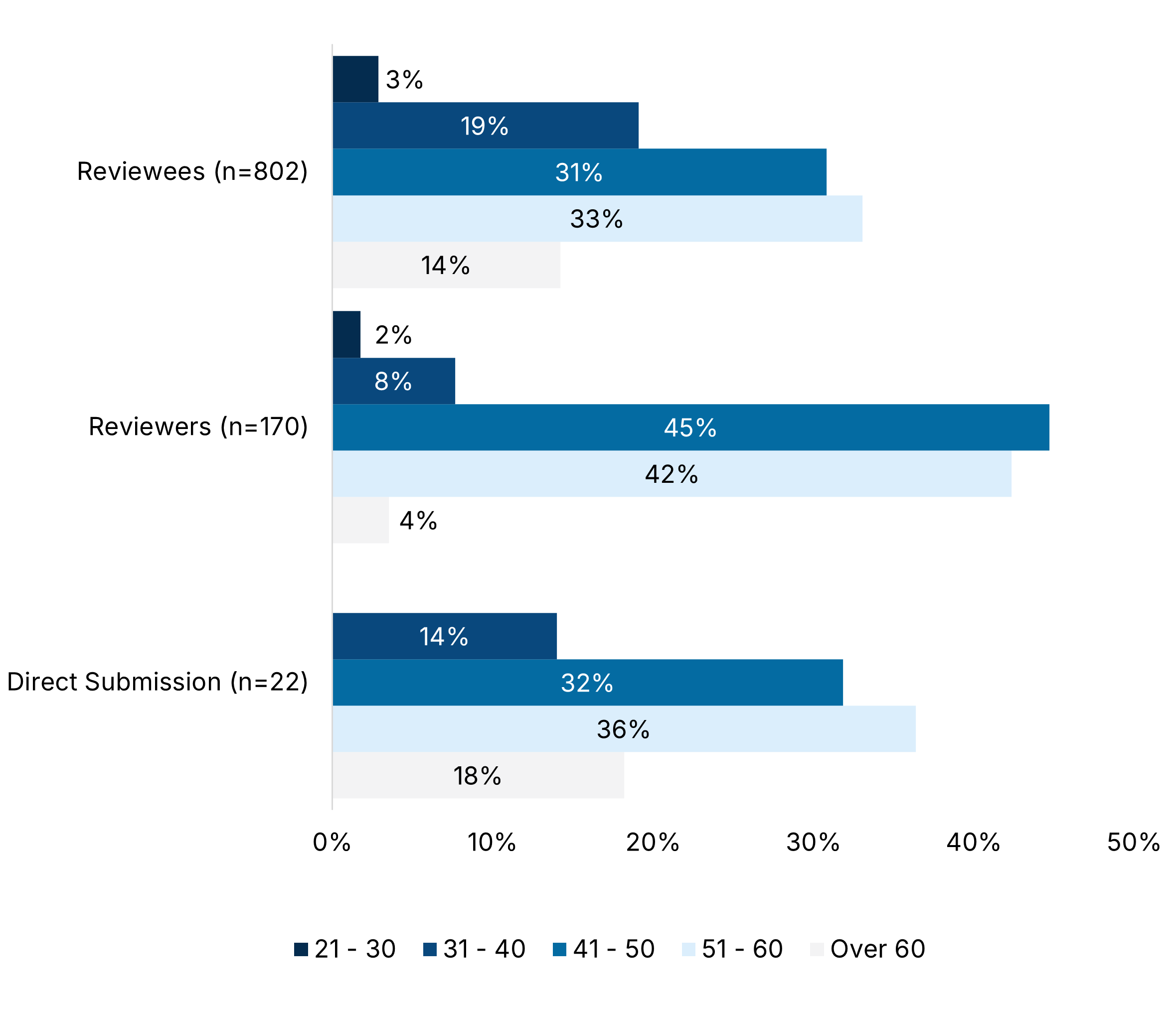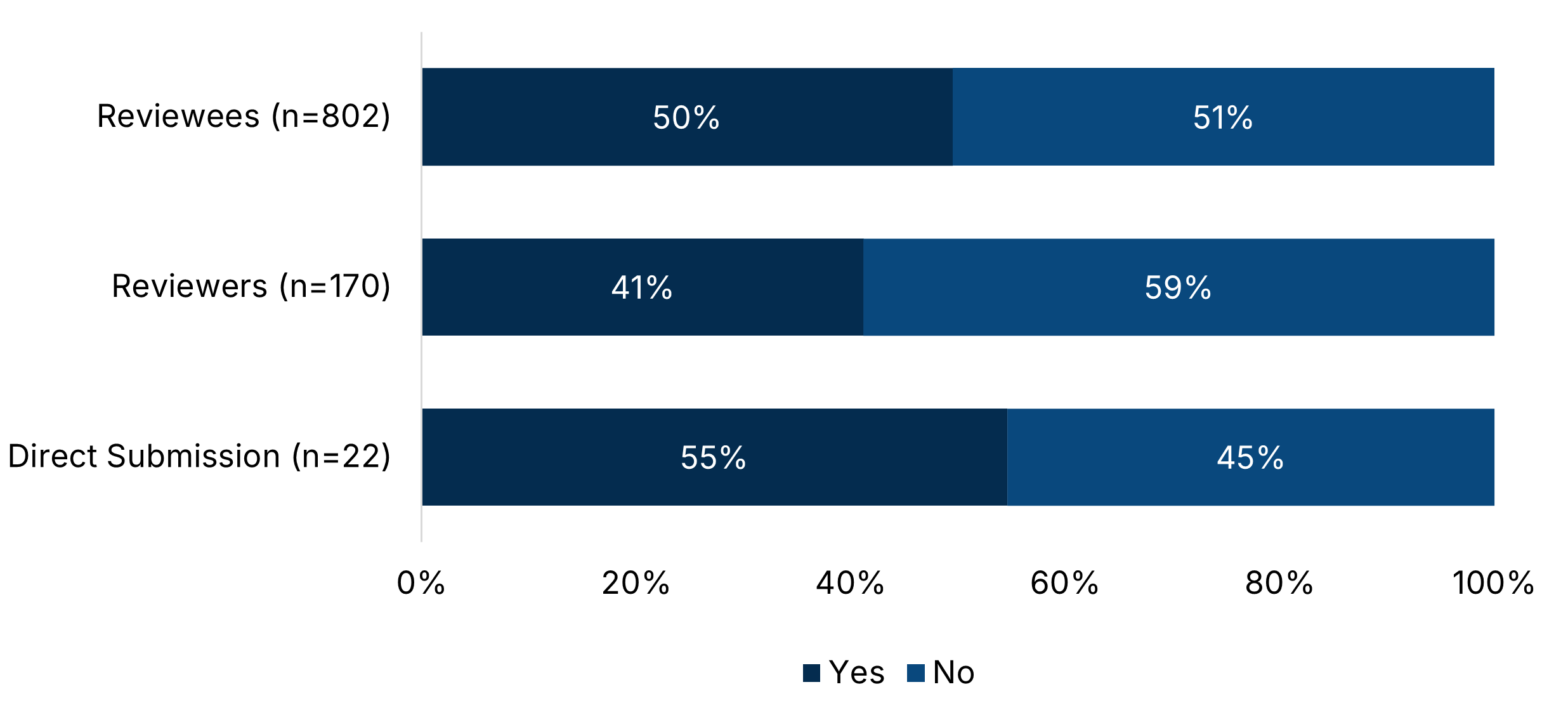Respondent profile
Employer information
Employer
Table 2 below shows that the majority of respondents (92% of reviewees and 83% of reviewers) were employed in the local authority context. This compares to 80% of the Register as a whole and shows greater engagement from those employed in the local authority context. Interestingly, Table 2 also shows that reviewers in the independent school and college sectors were much more likely to respond than reviewees.
{{fs-PU-2324-table-2="/section-components"}}
Table 3 shows that direct submission respondents experienced more varied employment circumstances. The 34.78% of direct submission respondents who answered ‘other’ included those who were self-employed, for example nursery owners; those working overseas at an international school; those working in some other capacity overseas; those working as a supply teacher; those working for a registered charity; or those working for a private company. This information demonstrates the range of employment circumstances of registered teachers who completed their PU by direct submission.
{{fs-PU-2324-table-3="/section-components"}}
Area of work
Respondents were asked to select the area in which they worked or taught:
{{fs-PU-2324-table-4="/section-components"}}
Just under 50% of all reviewee respondents were working in Primary, with 38% working in Secondary. Almost half of those respondents who complete by direct submission (48%) were working in Secondary. This percentage may be inflated by registrants working in independent schools or outwith Scotland, but further analysis of the data would be needed to determine if that were indeed the case. Other than that, however, the data shows that those who completed by direct submission were more likely than the other cohorts to be employed in Early Years (9%) or Further Education (13%).
Type of contract
Graph 1 provides further evidence of the less stable employment circumstances of registrants completing PU via the direct submission process with only 30% of registrants indicating that they held a permanent post. Further to that, 13% indicated that they were in a temporary short-term post with a further 13% indicating another type of contract. These percentages are higher than the percentages for reviewers and reviewees. The employment circumstances of reviewers were the most stable with 98% in permanent employment and the percentage for reviewees at 82%.
<span id="es-chart-01" class="table_caption" style="text-align:center; margin: auto; display: block; padding-top: 3.5rem">Graph 1: Type of contract</span>

Personal details
Sex
Graph 2 shows the respondent groups broken down by sex. The proportion of female respondents (80%) in the largest group, Reviewees, is broadly in line with the Register population (78%) and the cohort invited to complete the survey (79%). The reviewer response group shows a higher proportion of male respondents (27%). This is roughly in line with the cohort invited to respond (31%) and indicates that males are more likely to be overrepresented in the reviewer group than the Register as a whole. For Direct submissions, females represented 86% of respondents and were only 74% of the cohort.
<span id="es-chart-01" class="table_caption" style="text-align:center; margin: auto; display: block; padding-top: 3.5rem">Graph 2: Sex</span>

Age
Graph 3 shows the respondents broken down by age group. More than 90% of reviewers were aged 41 or over, which perhaps reflects the importance of experience in carrying out such a role. This contrasts with 78% of reviewees. Interestingly, 18% of those submitting a direct submission were over 60 years old with nobody between the ages of 21 and 30.
<span id="es-chart-01" class="table_caption" style="text-align:center; margin: auto; display: block; padding-top: 3.5rem">Graph 3: Age broken down by respondent type</span>

Teacher Induction Scheme
Respondents were asked if they had participated in the Teacher Induction Scheme, as a provisionally registered teacher, since it started in 2002. Approximately 50% of reviewees had participated in the scheme with the proportion rising to 55% for direct submissions.
<span id="es-chart-01" class="table_caption" style="text-align:center; margin: auto; display: block; padding-top: 3.5rem">Graph 4: Respondents who participated in the Teacher Induction Scheme </span>

Protected characteristics
When asked if they considered themselves to have a disability, 7% of reviewees (n=785), 2% of reviewers (n=165) and 0% of direct submissions (n=21) said that they did. This compares to 28% of respondents in the March 2024 Report on Equality Survey of Provisionally Registered Teachers who reported an illness or disability which was likely to last 12 months or more.
Respondents were also asked ‘Being mindful of protected characteristics (age, disability, gender reassignment, marriage and civil partnership, pregnancy and maternity, race, religion or belief, sex and sexual orientation) which of the following, if any, has had an impact on your engagement with Professional Update processes this year?’
Table 5 shows that the majority of respondents did not report any impact. Disability and pregnancy and maternity impacted a small percentage of participants, however, and it is noted that the cohort most impacted were those completing a direct submission (25%) with most preferring not to identify the cause of the impact (10%) or specifying another reason for the impact (10%). This is particularly interesting when compared with 0% of direct submission respondents saying that they had a disability, which indicates that something else they consider worthy of consideration could be impacting on that cohort’s engagement with PU.
{{fs-PU-2324-table-5="/section-components"}}
Employer information
Employer
Table 2 below shows that the majority of respondents (92% of reviewees and 83% of reviewers) were employed in the local authority context. This compares to 80% of the Register as a whole and shows greater engagement from those employed in the local authority context. Interestingly, Table 2 also shows that reviewers in the independent school and college sectors were much more likely to respond than reviewees.
{{fs-PU-2324-table-2="/section-components"}}
Table 3 shows that direct submission respondents experienced more varied employment circumstances. The 34.78% of direct submission respondents who answered ‘other’ included those who were self-employed, for example nursery owners; those working overseas at an international school; those working in some other capacity overseas; those working as a supply teacher; those working for a registered charity; or those working for a private company. This information demonstrates the range of employment circumstances of registered teachers who completed their PU by direct submission.
{{fs-PU-2324-table-3="/section-components"}}
Area of work
Respondents were asked to select the area in which they worked or taught:
{{fs-PU-2324-table-4="/section-components"}}
Just under 50% of all reviewee respondents were working in Primary, with 38% working in Secondary. Almost half of those respondents who complete by direct submission (48%) were working in Secondary. This percentage may be inflated by registrants working in independent schools or outwith Scotland, but further analysis of the data would be needed to determine if that were indeed the case. Other than that, however, the data shows that those who completed by direct submission were more likely than the other cohorts to be employed in Early Years (9%) or Further Education (13%).
Type of contract
Graph 1 provides further evidence of the less stable employment circumstances of registrants completing PU via the direct submission process with only 30% of registrants indicating that they held a permanent post. Further to that, 13% indicated that they were in a temporary short-term post with a further 13% indicating another type of contract. These percentages are higher than the percentages for reviewers and reviewees. The employment circumstances of reviewers were the most stable with 98% in permanent employment and the percentage for reviewees at 82%.
<span id="es-chart-01" class="table_caption" style="text-align:center; margin: auto; display: block; padding-top: 3.5rem">Graph 1: Type of contract</span>

Personal details
Sex
Graph 2 shows the respondent groups broken down by sex. The proportion of female respondents (80%) in the largest group, Reviewees, is broadly in line with the Register population (78%) and the cohort invited to complete the survey (79%). The reviewer response group shows a higher proportion of male respondents (27%). This is roughly in line with the cohort invited to respond (31%) and indicates that males are more likely to be overrepresented in the reviewer group than the Register as a whole. For Direct submissions, females represented 86% of respondents and were only 74% of the cohort.
<span id="es-chart-01" class="table_caption" style="text-align:center; margin: auto; display: block; padding-top: 3.5rem">Graph 2: Sex</span>

Age
Graph 3 shows the respondents broken down by age group. More than 90% of reviewers were aged 41 or over, which perhaps reflects the importance of experience in carrying out such a role. This contrasts with 78% of reviewees. Interestingly, 18% of those submitting a direct submission were over 60 years old with nobody between the ages of 21 and 30.
<span id="es-chart-01" class="table_caption" style="text-align:center; margin: auto; display: block; padding-top: 3.5rem">Graph 3: Age broken down by respondent type</span>

Teacher Induction Scheme
Respondents were asked if they had participated in the Teacher Induction Scheme, as a provisionally registered teacher, since it started in 2002. Approximately 50% of reviewees had participated in the scheme with the proportion rising to 55% for direct submissions.
<span id="es-chart-01" class="table_caption" style="text-align:center; margin: auto; display: block; padding-top: 3.5rem">Graph 4: Respondents who participated in the Teacher Induction Scheme </span>

Protected characteristics
When asked if they considered themselves to have a disability, 7% of reviewees (n=785), 2% of reviewers (n=165) and 0% of direct submissions (n=21) said that they did. This compares to 28% of respondents in the March 2024 Report on Equality Survey of Provisionally Registered Teachers who reported an illness or disability which was likely to last 12 months or more.
Respondents were also asked ‘Being mindful of protected characteristics (age, disability, gender reassignment, marriage and civil partnership, pregnancy and maternity, race, religion or belief, sex and sexual orientation) which of the following, if any, has had an impact on your engagement with Professional Update processes this year?’
Table 5 shows that the majority of respondents did not report any impact. Disability and pregnancy and maternity impacted a small percentage of participants, however, and it is noted that the cohort most impacted were those completing a direct submission (25%) with most preferring not to identify the cause of the impact (10%) or specifying another reason for the impact (10%). This is particularly interesting when compared with 0% of direct submission respondents saying that they had a disability, which indicates that something else they consider worthy of consideration could be impacting on that cohort’s engagement with PU.
{{fs-PU-2324-table-5="/section-components"}}
End of document
"
"
"
"
"
"
